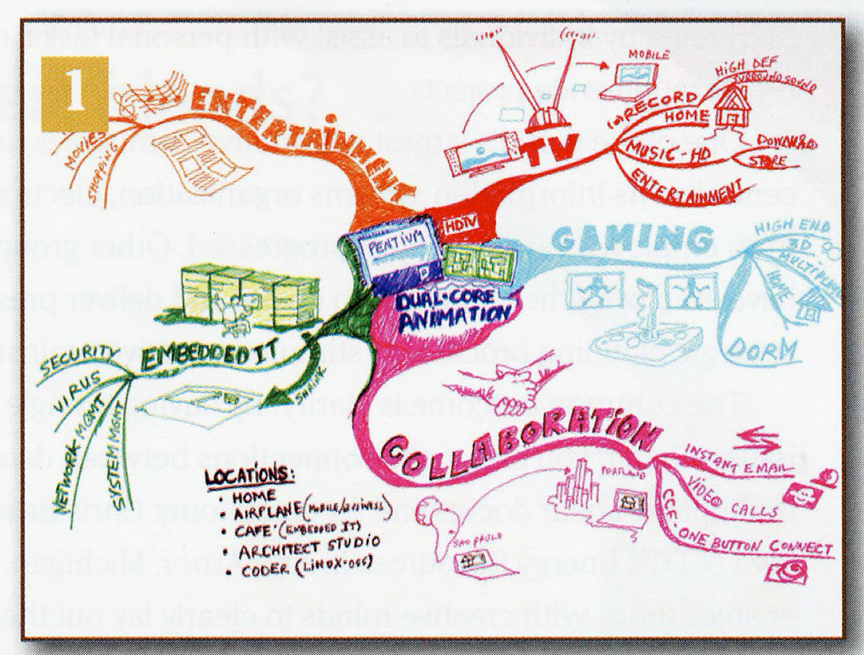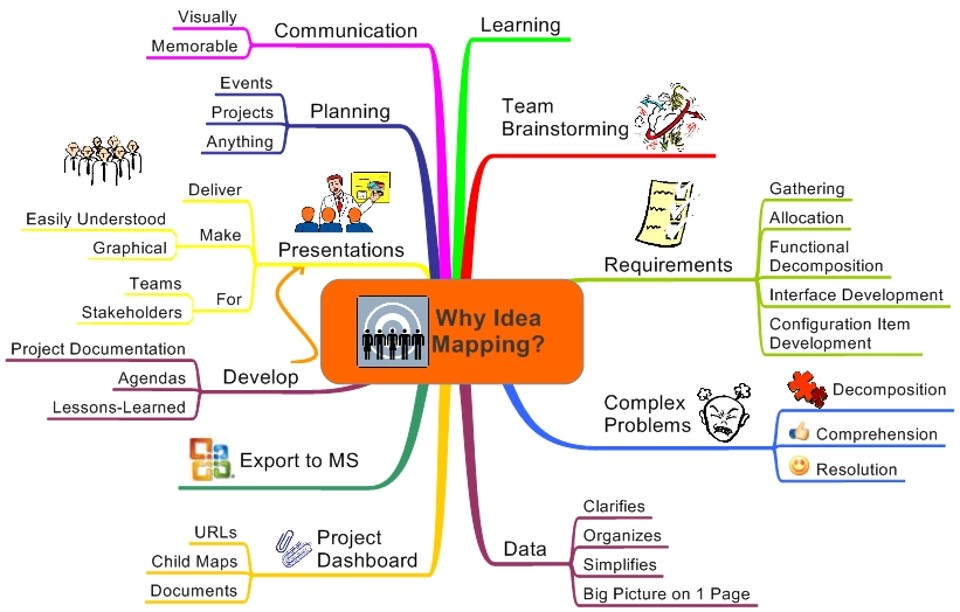Blog
Profiles in Project Management: Idea Mapping

3/29/2021
Surviving the “Accidental” Project Manager Role
Have you ever been thrust into a project management role without the training, experience, or tools to be successful? In today’s demanding work environment, it is a common experience for employees to be put into “sink or swim” situations. They are assigned a complex, multi-faceted, and time-sensitive project and simply told, “You need to get this done in 6 weeks. Please take care of it.” Idea Mapping, a process derived from and similar to Mind Mapping, is a powerful tool that can help you survive and thrive when an unexpected project is thrust upon you.
What is Idea Mapping?
Idea Mapping is a graphical method for representing ideas and concepts that is based on associative thought rather than traditional linear reasoning. And don’t worry. You don’t have to be a designer or artist to use it. According to Jamie Nast, a licensed master trainer and author of Idea Mapping, this “powerful yet simple whole-brained visual thinking tool enhances memory, note-taking skills, thought organization, planning, creativity, and communication.
David Halverson, instructor for Tombolo Institute adds, “Idea Mapping is a fairly simple, yet revolutionary methodology for capturing your creative thinking process and getting ideas down on paper. It is also a very helpful tool for managing the often-overwhelming amounts of information that relentlessly funnels into our workspaces. Idea mapping gives you a process to effectively organize and manage the daily and weekly deluge of email messages, text messages, phone calls, conference call, impromptu conversations, meetings, presentations and so forth by showing you how to put all that varied-source information into categories that are useful to you.”
Who Benefits from Using Idea Mapping for Project Management?
Idea Mapping is geared for those people who are not trained project managers, but because of workplace demands fall into the role. Halverson, also a former systems analyst and project manager for Boeing states, “quite frankly, 90 percent of the projects at Boeing, and at most other companies as well, are smaller projects that often fall into the hands of the accidental project manager. The Idea Mapping methodology is tremendously useful to a variety of people including project managers, strategic planners, business analysts, facilitators and product developers.”
The benefits of using Idea Mapping include:
- Enables those with creative minds to clearly layout their thinking process
- Enables those who are process-oriented to become more creative
- Promotes enhanced learning, memorizing and retention
- Makes complex issues easier to understand and communicate to others
- Provides increased productivity
What Does an Idea Map Look Like?
Creating an Idea Map begins with a simple, small sketch that represent the main topic at hand. For example, let’s say you work at a startup enterprise software company and you are asked to oversee the planning of your company’s participation in its first tradeshow. You might start your Idea Map with a central image that represents your main topic.
Using the logic of association, you would next draw perhaps 10 lines coming off that center image. On those lines, you would write the first 10 single words that first come to mind. For this example, you might write:
- Venue
- Transportation
- Booth
- Staffing
- Accommodations
- Software demo
- Promotions
- Budget
- Entertainment
- Shipping
These are referred to as the Bloom of Ideas. Next, you would come up with a single word you associate with each of those 10 words. For example, you might associate “hotel” with venue and “airfare” with transportation and so forth. To further develop the Flow of Ideas, you would continue to further associate words that branch off the original 10 words. Your Idea Flow for “Transportation” might branch out like this:

According to Nast, a fully developed Idea Map can distill information from hours of meetings and many pages of notes into a color-coded, single-page diagram that summarizes—at a glance—the project and its overall structure. Idea Maps have been used to summarize technical details for products, to map out sales processes, to present marketing strategies, and much more.
Example of a Fully Developed, Hand-drawn Idea Map:

Image provided by Jamie Nast
How is Idea Mapping Taught at Tombolo Institute?
Halverson states, “In the classes I teach at Tombolo Institute, I train students to use MindManager in conjunction with presenting the concepts and practical applications of Idea Mapping. The MindManager software helps students learn to capture, structure, and organize information related to a project they are managing. We give them ample opportunity to experiment with the software and create maps that are immediately useful. What excites students about the class is learning how to move an idea from an amorphous concept into a practical, actionable project. Idea mapping enhances their ability to fully develop their ideas and present a plan for the implementation of a particular idea. We also have them work collaboratively to create a team map and create an outline of a simple project.”
The competencies students acquire during the class include:
- Develop and capture Idea Maps using MindManager software
- Notate and structure information into a useful product
- Work collaboratively to create a team map
- Create an outline of a simple project using the project management capabilities of MindManager
Example of an Idea Map Created with MindManager Software

Image provided by Jamie Nast
For current class offerings in Idea Mapping and Project Management with MindManager, please see the Tombolo Institute catalog.
About Project Management Studies at Tombolo Institute
Bellevue College Continuing Education is a Project Management Institute (PMI®) Registered Education Provider. Required courses count toward the education requirements for the Project Management Professional (PMP®) and Certified Associate in Project Management (CAPM®) certifications.
Learn more about our certificate program in project management.



